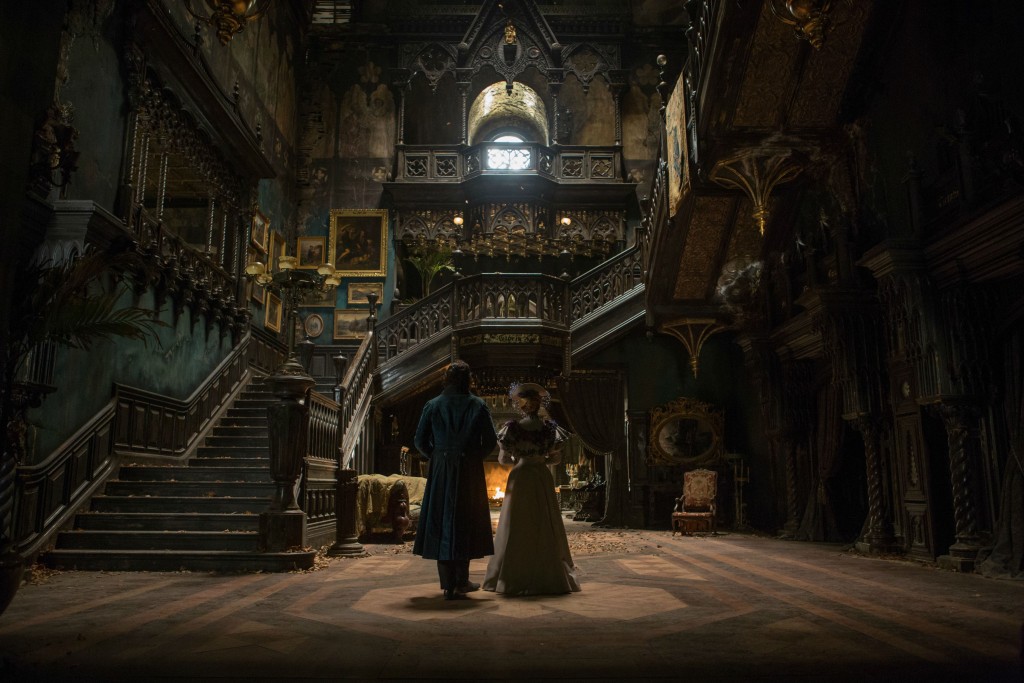
From Director Guillermo Del Toro, the creative force behind films such as as Blade 2, Hellboy and most notably Pan’s Labyrinth, comes Crimson Peak, an elusive, moving and haunting tale set in the early years of the 20th century.
The story of Crimson Peak centers on a young woman named Edith Cushing (played by the ethereal Mia Wasikowska) who marries a mysterious yet charismatic young man from England, Sir Thomas Sharpe (Tom Hiddleston), in the wake of a family tragedy. Edith becomes swept away by Thomas and taken to the decrepit Sharpe mansion situated on a peak of red clay in Northern Cumberland. Edith remains there with Thomas and his gloomy, capricious sister, Lady Lucille Sharpe (Jessica Chastain).
Within the halls of the mansion, Edith experiences strange occurrences, including spine-chilling encounters with restless, eerie specters that ascend from the clay mines.
Crimson Peak is an enchanting and ghostly fantasy that elaborates on varying themes of affection, mystery and the genre of horror. To Del Toro’s credit, the film conveys these concepts in ways that generate a sense of emotion and mystical meaning.
Each varying aspect of the film, such as the panoramic sets, intricately designed costumes, spectacular lighting and cinematography, all profoundly contribute to the momentum and atmosphere of the story. These aspects are significant, in that they culminate in presenting the story with authenticity and inspiration.
In terms of the storyline and mood, Crimson Peak explores the history and time period with a painterly vision and provides the opportunity to experience the story’s progression within the context of longing and terror. The film is undeniably a feast for the eyes that takes us on a breathtaking and poignant journey that entrances and astonishes from beginning to end.
Tom Hiddleston is at his best in the role of the enigmatic and charming young Englishman, Sir Thomas Sharpe. Every nuance of Hiddleston’s character — his body language, facial expressions and emotional subtext – palpably piece together the authenticity of his character, as a whole. All of these idiosyncrasies are underlying allusions of his troubled nature — as it seems he holds much darker secrets deep within his soul.
Del Toro makes a remarkable effort to express, in every detail and variation, each layer of the narrative. He does this through innovative visual effects, fluently paced dialogue along with an appealing use of mystery and discrete use of symbolism. This reflects on his unremitting use of intrigue and exploration into the elements of suspense and the supernatural infusing lifelike energy within the bizarre ambiance of the tale. The escalation of dread and trepidation in the mind and character of Edith contribute to the dark and mystifying impressions looming in the darkness throughout every scene.
The movie’s CGI effects also had a major effect on the entrancing encounters throughout the movie. The spirits in the Crimson Peak were reminiscent of the ethereal apparitions in films from the golden age of Hollywood. Their particular auras, colors and manifestations, which were interpreted in artistic shades and moody movement, conveyed gradations of emotions, expressions and meanings. There were more to the specters than their sinister appearance; as the story progressed, they became a physical representation of Edith’s deep introspectiveness along with her conflicting internal struggles.
In summary, Del Toro’s latest masterpiece is a stunning and extraordinary film full of complex characters and extravagant backdrops. Crimson Peak creatively demonstrates the internal battles within the human mind and lucidly expresses the many-layered themes of sorrow, love and the mysteries of life.

